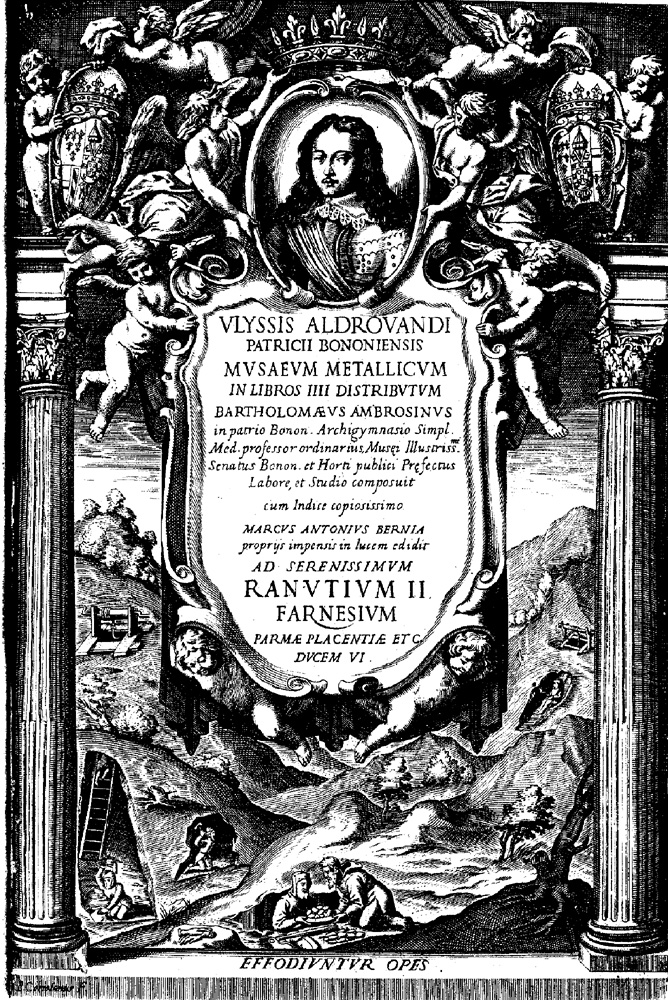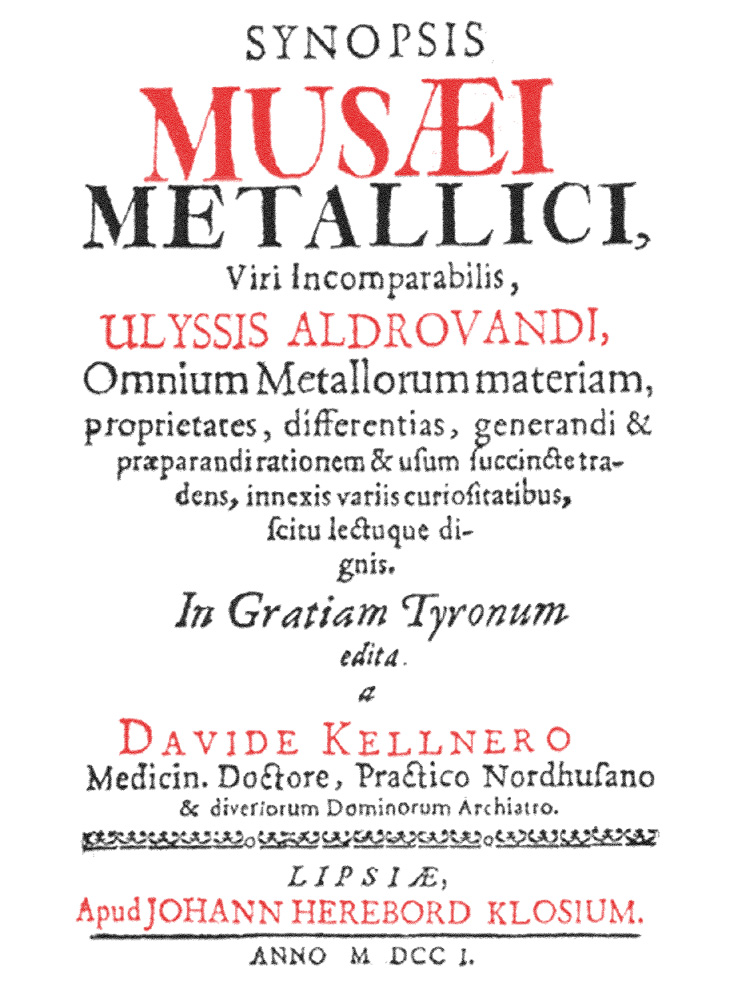ALDROVANDI, Ulysse.
(1522 – 1605)
Aldrovandi is regarded as one of the foremost zoologists of the Renaissance. He was born of a respectable burgher family and it was intended he should become a merchant. However, the work attracted him so little he began studying first jurisprudence in Bologna and then philosophy and medicine at Padua and Rome, receiving the degree of Doctor of Medicine in 1552. In 1560, he was appointed professor of natural history at the University of Bologna, where he remained the next 40 years, until his death. As a professor he was a favorite lecturer of the students, and his talks on botany and pharmacology were heavily attended. In order to provide teaching aids for his lectures, he founded in 1568 the Bologna City Gardens and became its first director. About this period, he was also appointed inspector of drugs and as a consequence published, Antidotarii Bononiensis Epitome (Bononiæ, 1615), which became a model for many subsequent pharmacopædias.
Throughout his adult life, Aldrovandi spent his financial and leisure resources in the accumulation of a very large collection of natural history objects. He employed the artists of the city to create woodcuts of the objects for use in a series of large, beautifully illustrated books, covering the natural history spectrum. However, at his death, only four volumes had been published. Before he died though, the Bologna City goverment, in recognition of his scientific contributions, had doubled his salary. In gratitude, Aldrovandi bequeathed his collections and unpublished manuscripts to the city, where today the remains are located in the city's library and museum. This was also a shrewd move because after his death, the city decided to continue the publication of the manuscripts. The result is that all of the various researches are embodied in Aldrovandi's Opera Omnia (Bononiæ, 1599-1668), which consists of 14 large folio volumes, covering all aspects of natural history, and forming one of the great scientific works of the seventeenth century.
Biographical references: ABI: I 26, 238-304; II 8, 407-422. • Adversi, A., "Nuovi appunti su Ulisse Aldrovandi, bibliofilo, bibliotecario e bibliografo, a sulla sua inedita Bibliologia", Bibliofilia, 68, (1967), 51-90. • Adversi, A., "Ulisse Aldrovandi: bibliogilo, bibliografe e bibliologo del cinquecento", Annali, Scuola Speciale per Archivisti e Bibliotecari, 8, (1968), nos. 1/2, 85-181. • Aldrovandi, U., Catalogo dei manoscritti di Ulisse Aldrovandi. Edited by L. Frati, A. Ghigi & A. Sorbelli. Bologna, N. Zanichelli, 1907. xxi, 287 p., portrait. • Baldacci, A., et al., Intorno alla vita e alle opere di Ulisse Aldrovandi. Bologna, L. Betrami, 1907. 223 p. • Benvenuti, Dizionario degli Italiani all'Estero, 1890. • Capparoni, Profili Bio-Bibliografici, 1928-32: 1, 17-20, portrait. • Catalogue of Portraits of Naturalists: 106 [18 portraits listed]. • Comitate pel Centerario di Ulisse Aldrovandi, Onoranze a Ulisse Aldrovandi vel terzo centenario dalla sua morte celebrate in Bologna nei giorni XI, XII, XIII giugno MCMVII. Inola, 1908. [i]-vi, [1]-429 p., 14 plates. [Collection of commerative addresses.]. • Dizionario Biografico Italiani: 2, 118-24 [by G. Montalenti]. • DSB: 1, 108-10 [by C. Castellani]. • Fantuzzi, G., Memorie della Vita di Ulisse Aldrovandi medico e filosofo Bolognese. Bologna, 1774. vi, 263 p. • Frati, Dizionario Bio-bibliografico Italiani, 1933. • Imperatori, Dizionario di Italiani all'Estero, 1956. • Lambrecht & Quenstedt, Catalogus, 1938: 6-7. • Mieli, Gli Scienziati Italianì, 1921: 328-36, portrait, manuscript example. • Olmi, G., Ulisse Aldrovandi: Scienza e natura nel secondo cinquecento. Trento, Unicoop, 1976. 129 p. [Published as: Quaderni di storia e filosofia della scienza, no. 4.]. • Parenti, Aggiunte al Dizionario, 1952-60. • Pattaro, S.T., Metodo e sistema delle scienze nel pensiero di Ulisse Aldrovandi. Bologna, Cooperativa Libraria Universitaria Editrice, 1981. 251 p. [Published as: Collana di studi epistemologici, no. 3.]. • Poggendorff: 1, cols. 27 & 1527. • Sarjeant, Geologists, 1980: 2, 411-2. • Schrader, Biographisch Lexicon der Tierärtze, 1863. • Tosi, A., ed., Ulisse Aldrovandi e la Toscana: Categgio e testimonianze documentarie. Florence, Olschki, 1989. [1]-472 p., [19] p. of plates, illus. • WBI. • World Who's Who in Science: 26.

1. Latin, 1648 [First edition].
[Contained within an ornamental compartment:] Vlyssis Aldrovandi | Patricii Bononiensis | Mvsaevm Metallicvm | In Libros IIII distribvtvm | Bartholomævs Ambrosinvs | in patrio Bonon Archigymnasio Simpl. | Med. Professor ordinurius, Musei Illustriss.mi | Senatus Bonon. et Horti publici Prefectus | Labore, et Studio composuit | cum Indice copiosissimo | Marcvs Antonivs Bernia | proprys impensis in lucem edidit | ad serenissimvm | Ranvtivm II | Farnesivm | Parmæ placentiæ etc. | Dvcem VI. | [At base:] Effodivntvr Opes.
2°: ¶3 A-Z6 Aa-Zz6 Aaa-Zzz6 Aaaa-Nnnn6 Oooo4 (4O2 missigned 4P2); 499l.; [6], 1-979, [13] p., engraved title page, many woodcuts in text, printer's devices, capital letters. Although no date appears on the title page, the last page has the colophon: "Bononiæ, Typis Io. Baptistæ Ferronij 1648." Page size: 350 x 236 mm.
Contents: [2 pgs], Title page, verso blank.; [2 pgs], "Serenissme Princeps."; [1 pg], "Bartholomævs Ambrosinvs Bebeuolo Lectori S."; [1 pg], "Mvsæum hoc Metallicum Magni Vlyssis Aldrovandi ..."; 1-205, "Vlyssis Aldrovandi Patricii Bononiensis Mvsæi Metallici Liber Primvs. Ordinis Ratio."; 206-272, "... Lib. II. De Terra in Genere."; 273-434, "... Liber Tertivs. De Svccis Concretis."; 435-979, "... Liber IV. De Lapidibvs in Genere."; [13 pgs], "Index Rervm & Verborum locupletissimus."
Very scarce. Edited by Bartolomeo Ambrosini [see note below]. Some forty years after he died, Aldrovandi's Musaeum Metallicum was published as a thick folio volume. Since his death, the work had existed as a manuscript, "Geologica ovvero Fossilibus" in the library collections of the University of Bologna, which had been bequeathed all of Aldrovandi's manuscripts. Even unpublished, many scholars studied it as a resource for their own researches. The value others placed upon Aldrovandi's material did not go unnoticed, which is why a former student of the author, Bartolomeo Ambrosini was entrusted by the Bologna senate to edit the material Aldrovandi had accumulated and oversee its publication. The final product is a superb book.
The work consists of a single volume divided into four books: on metals, earths, succi concreti (concrete juices), and stones (minerals, rocks, and fossils). Within each of these books, whole chapters are devoted to the consideration of a single "fossil." In a style typical of its time, each chapter then describes the fossil's medical properties, synonyms, localities, origins, varieties, and uses. Aldrovandi includes references to classical and medival authors through out the volume in a fashion that anticipated modern scholars by compiling long lists of authorities but omitting those commonly cited (Partington, 1961-70). The antiquarian nature of the book commonly gives the names and descriptions of the items listed a strange, unrecognizable character. However, Foresti (1887) attempted to ease the struggle by matching relatively modern names to Aldrovandi's. The comprehensive index included at the end of Musaeum Metallicum also makes this a reader friendly book.
Perhaps the most outstanding feature for the connoiseur of mineralogic literature are the several hundered woodcuts scattered throughout the volume. Some of these are full page but most are smaller, with many possessing a quaint, interesting character. These figures are designed to illustrate features described in the text, but since minerals do not easily lend themselves to illustration, the pictures "rather require the text to explain them" (Adams, 1938). That Aldrovandi was a man of accumulation is clearly shown by his inclusion of all facts that came to his attention without apparently any critical faculty to distinguish between the true and imaginary, the important and nonessential. A great amount of scientific value is contained in Musaeum Metallicum but an overburden must be removed to discover those nuggets. In truth, the author was a product of his time. The influence of the church and other authorities did not bind his writings and ideas as they had past authors, "and so," as Adams (1938) writes, "one gathers the impression that he was writing at the opening of a new age ..."
Bartolomeo Ambrosini. (Born: 1587; Died: 1688) Italian physician & botanist. Ambrosini was a pupil of Aldrovandi, who successively became professor of philosophy, botany and medicine at the University of Bologna. He also became director of that city's botanical gardens.
Bibliographical references: Adams, Birth and Development, 1938: 165-8. • BL [459.b.7.]. • BMC: 1, 27. • CBN: 2, col. 58. • Cobres, Deliciæ Cobresianæ, 1782: 1, 161-4. • Foresti, L., Sopra alcuni fossili illustrati e descritti nel Musaeum Metallicum di Ulisse Aldrovandi , 1887, 1881: 1887, 81. • Freiesleben, Sächsische Mineralien-Verzeichnisse, 1828: no. 2. • Gatterer, Mineralogischen Literatur, 1798-9: 1, 41. • Mieli, Gli Scienziati Italianì, 1921: 328-36. • NUC: 8, 44-7 [NA 0154101]. • Partington, History of Chemistry, 1961-70: 2, 92-4. • Roller & Goodman, Catalogue, 1976: 1, 25. • Schröter's Journal für die Liebhaber: 1, 3 & 385. • Sinkankas, Gemology Bibliography, 1993: no. 72. • Ward & Carozzi, Geology Emerging, 1984: no. 43. • Wilson, History of Mineral Collecting, 1994: 19, 27-8, 158 & 201. (Ambrosini) ABI: I 40, 215-218; II 14, 315. • Biographie Universelle: 1, 572 [by Chaussier & Adelon]. • Jöcher, Gelehrten-Lexikon, 1750-51. • Mazzetti, Repertorio di Tutti i Professori, 1848. • Mazzuchelli, Gli Scrittori d'Italia, 1753-63. • WBI. • World Who's Who in Science: 42.

2. Latin, 1701 [Abridged edition].
[In black:] Synopsis | [in red:] Musæi | [in black:] Metallici, Viri Incomparabilis, | [in red:] Ulyssis Aldrovandi, | [in black:] Omnium Metallorum materiam, | proprietates, differentias, generandi & | præparandi rationem & usum succincte tra- | dens, innexis variis curiositatibus, scitu lectuque di- | gnis. | In Gratiam Tyronum | edita | â | [in red:] Davide Kellnero | [in black:] Medicin. Doctore, Practico Nordhufano | & diveriorum Dominorum Archiatro. | [ornate rule] | Lipsiæ, | [in red:] Apud Johann Herebord Klosium. | [in black:] [rule] | Anno M DCC I.
12°: π2 A-K12 L9; 131l.; [4], [1]-258 p. Title in red and black. Page size: 128 x 75 mm.
Contents: [2 pgs], Title page, verso "Deo | & | Amicis."; [2 pgs], "Lectori Curioso & Benevolo | S.P.D."-signed David Kellner, M.D.; 1-258, Text.
Rare. Edited, paraphrased, abridged edition by David Kellner [see note below] of Mvsaevm Metallicvm (Bononiæ, 1648). The work is divided into two books. The first (page 1-67) is "De Metallis in genere," which gives an overview of metals, their origins, reason for existance, etc. The second book (pages 68-258), titled "De Metallis in specie," gives detailed descriptions of various metals, including notes on the both the physical and mystical properties.
David Kellner. (Born: Gotha, Germany, 16-; Died: 17-) German physician. Kellner studied medicine in Helmstedt, receiving his M.D. in 1670 (or 1673). He worked in Nordhausen, and may have been a physician to the court. The second of his surgical dissertations is dedicated to Johann Langguth, a physician in the service of Duke Ernst of Saxony. It is possible that Langguth advanced Kellner in his work. He dedicates one of his books to Johann Scheib, the surgeon and barber of Gotha (the prince's city of residence) whom Kellner calls his friend and patron. He authored several treatises concerning mining, assaying and metallurgy.
Bibliographical references: BL [977.a.25.]. • BMC: 1, 27. • CBN: 2, col. 58. • Freiesleben, Sächsische Mineralien-Verzeichnisse, 1828: no. 2. • Gatterer, Mineralogischen Literatur, 1798-9: 1, 41. • NUC: 8, 44-7 [NA 0154125]. • Wilson, History of Mineral Collecting, 1994: 201. (Kellner) Hirsch, Biographisches Lexikon, 1884-8: 3, 499. • Jöcher, Gelehrten-Lexikon, 1750-51: 2, 2059-60. • Jöcher, Gelehrten-Lexikon, Supplement: 3, 187-8. • Poggendorff: 1, col. 1240.
.